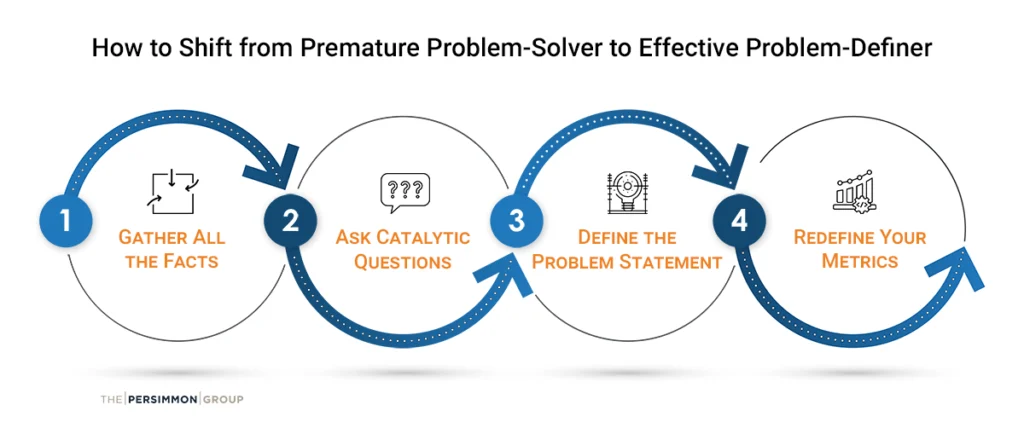You’re in another high-stakes meeting. The problem is complex, and all eyes are on you. As the leader, you feel the weight of expectations. You need to have the answer, and you need it now. So you do what you’ve always done: you offer a solution. Quick. Decisive. Confident.
But what if I told you that this moment—the one where you feel most like a leader—is when you’re at risk of spectacularly failing your team?
The Siren Song of Solutions
Let’s be honest: there’s a certain thrill in being the problem-solver. It feels good. It feels like leadership. But this addiction to quick fixes is a silent killer in organizations, stifling innovation, disempowering teams, and ultimately leading to subpar outcomes.
So Why Do We Do It?
The Psychology of the Quick Fix
- The Competence Trap: Many executives rose through the ranks because of their problem-solving abilities. It’s comfortable. It’s what got you here. But what got you here won’t get you there.
- The Illusion of Control: In a world of uncertainty, having a solution—any solution—feels like control. It’s a security blanket for leaders facing complex challenges.
- The Speed Imperative: In our fast-paced business world, there’s immense pressure to act quickly. “Analysis paralysis” is seen as a cardinal sin.
- Ego and Identity: Many leaders tie their self-worth to their ability to have all the answers. It’s not just about solving the problem; it’s about being the person who solves problems.
- The Applause Effect: Quick solutions often get immediate positive feedback. It feels good to be the hero, even if that heroism is short-lived.
- Cognitive Biases: We’re all subject to biases like confirmation bias and the availability heuristic, which can make us overconfident in our initial ideas.
The Hidden Costs of Heroic Leadership
Picture this: You’re leading a project to launch a new product line. The deadline is tight, and in your haste to move things along, you start every meeting with your ideas for solutions. Your team nods along, offers a few tweaks, and you leave feeling productive. But beneath the surface, trouble is brewing.
Your marketing lead has reservations about the target audience but doesn’t speak up. The tech team sees potential issues with the proposed features, but you must have considered them already. And that junior team member with the wildly innovative idea? They never find the courage to share it.
Fast forward six months. The product launches to a lukewarm reception. Customer feedback reveals issues that, in hindsight, were glaringly obvious. Your team scrambles to make adjustments, but the damage is done. Morale plummets, fingers point, and you’re left wondering how it all went wrong.
This scenario plays out in companies every day. When leaders consistently jump to solutions, they create a cascade of unintended consequences. Teams stop thinking for themselves, complex problems get band-aid solutions, and innovation suffers. The result? A culture of dependence, shallow thinking, and missed opportunities. All because you thought your job was to have all the answers.
Understanding the REAL Problem: The Key to Effective Solutions
So, if rushing to solutions isn’t the answer, what is? It’s time to reframe your role. Your value as a leader isn’t in having all the answers—it’s in ensuring your team uncovers the real problem before jumping to solutions.
Here’s How to Shift from Premature Problem-Solver to Effective Problem-Definer:
- Gather All the Facts
Before your team starts brainstorming solutions, ensure they have all the necessary information. Create a structured approach to fact-gathering:- Develop a “fact-finding checklist” for common types of problems your team faces.
- Assign team members to be “fact-checkers” for different aspects of the problem.
For example, imagine you’re facing declining sales. Instead of immediately brainstorming marketing campaigns, you could task team members to gather data on customer feedback, usage patterns, and competitor offerings.
- Ask Catalytic Questions
Instead of providing answers, focus on questions that stimulate thinking:- “What assumptions are we making that we haven’t tested?”
- “If resources were unlimited, how would we approach this?”
- “What would our biggest competitor do in this situation?”
- Define the Problem Statement
Once you have the facts, work with your team to craft a clear, concise problem statement. Use the “5 Whys” technique to get to the root cause. For instance, if the initial problem seems to be “declining sales,” asking “why” repeatedly might reveal that the real issue is “outdated product features that no longer meet evolving customer needs.” - Redefine Your Metrics
If you’re measuring your success by how many problems you personally solve, you’re optimizing for the wrong outcome. Start measuring:- How many great ideas come from your team
- The diversity of perspectives in decision-making
- The level of ownership your team takes in implementing solutions
By shifting your focus from personal problem-solving to team empowerment, you’re not just solving today’s problems—you’re building a team capable of tackling any challenge that comes their way.
The Payoff: From Hero to Hero-Maker
Making the shift from heroic leader to a problem-definer doesn’t happen overnight. The transition isn’t easy, but it’s worth it. If you stay the course something magical happens. Your team becomes more engaged, more creative, and more committed. Solutions are more robust because they’ve been examined from all angles. Implementation is smoother because people are fighting for ideas they helped create.
Remember, in the complex world of modern business, the best leaders aren’t those with all the answers. They’re the ones who empower their teams to find answers nobody else has thought of yet. By focusing on defining the real problem and creating an environment where your team can thrive, you’re not just solving today’s challenges—you’re building an organization capable of conquering whatever the future holds.











